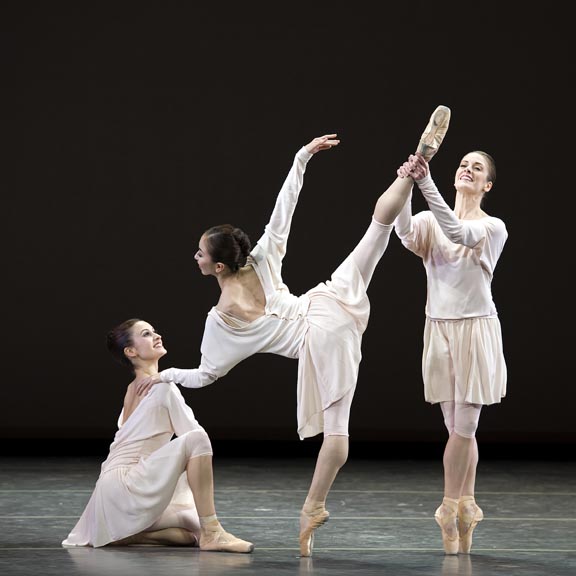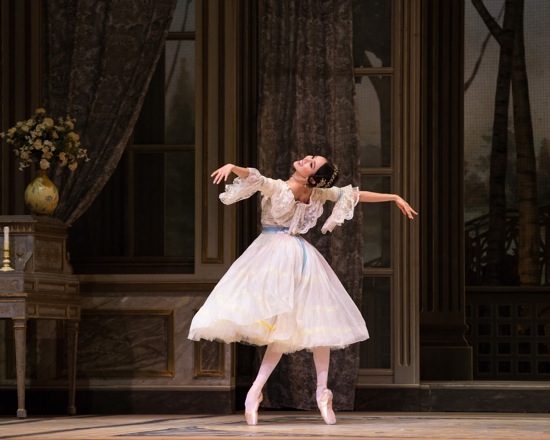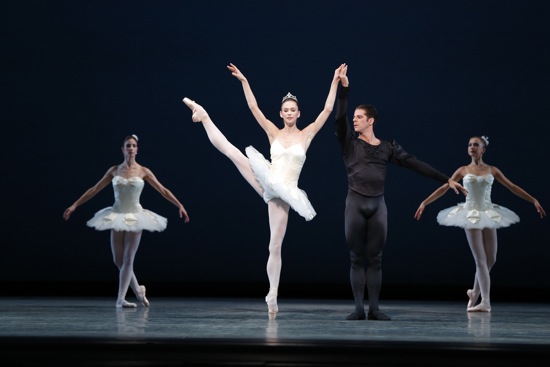There’s something about walking into the Metropolitan Opera House for American Ballet Theatre’s spring season that always reminds me why it is I live in New York. While I sometimes find their counterpart across the plaza, New York City Ballet, more exciting for the chance to see dancers rising through the ranks and a wide array of ballets new and old, ABT offers a certain grandeur that never fails to draw me back. While the spring season primarily consists of evening-length classics (think Swan Lake, Don Quioxte), Thursday night’s program offered three disparate ballets, ranging from Mark Morris’s breezy modernity to Balanchine’s ode to classicism.
First up was Drink to Me Only With Thine Eyes, originally made for the company by Mark Morris in 1988. The ballet is set to a number of piano etudes by Virgil Thomson (an important modernist composer, who also composed Gertrude Stein’s opera Three Saints in Four Acts, which Morris later choreographed) played by Barbara Bilach on a piano at the back of the stage. The ballet’s easy classicism is intermixed with a sense of grounded-ness that belies its creator’s modern dance background. The loose white costumes echo this sense of ease, as the dancers come and go, creating intricate patterns and surprising images.

Melanie Hamrick, Yuriko Kajiya and Marian Butler in Drink to Me Only With Thine Eyes.
Photo: Gene Schiavone.
Although this work is largely non-hierarchical, with no clear principals, there were a few dancers in particular who caught my attention. Joseph Gorak, still in the corps de ballet, was a standout in the central role. With feet and extensions that would make many a ballerina jealous, he breezed through a series of pirouettes which ended in controlled extensions with grace. Kristi Boone’s clarity and daring was stunning, yet assured.
A Month in the Country, by British choreographer Frederick Ashton, is “freely adapted” from the play by Ivan Turgenev. The set for this ballet is absolutely stunning—richly detailed layers frame a central living space, a smaller piano room, and the garden beyond. The ballet tells the story of Natalia Petrovna (Hee Seo), the bored wife of an older man, whose life at her country house is interrupted by the arrival of a tutor (David Hallberg) who becomes entangled with both Natalia and her young ward (Sara Lane).
I had never seen Seo dance a principal role before this performance, and was quickly converted. She exuded elegance in her pristine lines and silky movements and was convincing in her portrayal of Natalia’s jealously and later heartbreak. Hallberg was wonderful as always, even out of his usual princely element.
Everyone seems to have an opinion about ABT doing Balanchine—whether they should, if they’re doing it right, which company members are cut out for it—so anticipation was high for their performances of Symphony in C. The ballet is a study in structure and style, and Balanchine’s particular brand of classicism. Each of the four movements features a principal couple, two secondary couples, and a corps de ballet of women in white tutus and tiaras like the principals (the men are in black).
Stella Abrera was regal and refined in the 1st movement, ably partnered by Eric Tamm. In the grand and lyrical 2nd movement, Marcelo Gomes’s gaze and attentive partnering immediately focused our attention on Polina Semionova (although sadly, we don’t get to see much of his own dancing in this role).
Natalia Osipova and her partner Ivan Vasiliev soared with the incredible buoyancy we have come to expect from these Russian superstars in the 3rd movement (she even more so than he), but I found myself wishing they would turn down the Bolshoi showiness a notch (an open-mouthed ah-ha! smile seemed to punctuate each movement). Simone Messmer, along with partner Jared Matthews, was a breath of fresh air in the spirited 4th movement, executing the difficult choreography with élan and airy confidence.
While the corps de ballet looked a bit uneven at times, the dancers pulled together for the always-thrilling finale, in which the entire cast returns to the stage, dancing in unison at high speed. Purists may argue that ABT doesn’t have the appropriate style or speed for Balanchine, but it is always a delight to see this ballet, and was a fine opportunity to see some of their soloists in particular shine.

